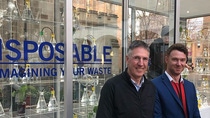Dilution is not the solution to pollution
BASF is a proud sponsor of Science Gallery Melbourne. To gain a better understanding of some of the works featured in the 2019 ‘Disposable’ season, Alice Endersbee, BASF GROW Graduate, caught up with one of the artists behind one of the most controversial installations, Professor Peter Scales.
We often take for granted the clean drinking water at our fingertips, but for 700 million people around the world, this is not the case. Every day hundreds of millions of people consume water contaminated by sewerage due to poor waste management. Professor Peter Scales of the University of Melbourne is determined to find sustainable and economical methods to remove pollutants from waste water to produce clean, safe drinking water.
A country kid, Peter moved to the city primarily to play AFL. For Peter, university came second to sport as pursuing a career in STEM was not front of mind. Luckily Peter persisted and graduated with an Honours degree in Physical Chemistry. After graduating, he transitioned into industry, a period of his life Peter says helped him to ‘understand the facts of a problem’.
After many years working in chemical engineering research, Peter was looking to experiment with something more creative when he was offered the opportunity to collaborate on an art-meets-science installation that reimagines resources, or in this case, wee-sources.
While at first glance the aptly named ‘Urinotron’ installation appears to be nothing more than three huge vats of human urine connected by wires in a beautiful glass enclosure, in actuality, it is a very clever installation that is able to transform human urine in to electricity before returning it to pure water. Designed to make science accessible to the public, Urinotron is a creative demonstration of scientific principles and evidence-based understanding through the lens of waste water recycling. As urine passes through the Urinotron, each stage of the separation process removes a specific class of contaminant including fertilizers, salts and organic molecules. (Fun fact: BASF’s filter mechanisms are used in this process to remove salts). While some of the removed contaminants are valuable and can also be recovered and reused, other undesirable pollutants are prevented from re-entering the environment.
Urinotron was part of ‘Disposable’, Science Gallery Melbourne’s 2019 pop up exhibition. Like most works featured in Science Gallery, this installation is designed to push boundaries and challenge thinking about the overlap where art meets science. Urinotron also encourages public interaction, as visitors can donate their own urine to the installation, or even charge their mobile phone with the electricity it emits.
While the concept of eating food irrigated by recycled waste water may be daunting to many of us, Peter believes that the power of forums such as Science Gallery Melbourne is to demonstrate scientific principals and evidence-based understanding in a creative and engaging way. Peter believes once the general public understand a technique, they are more likely to trust it and hopes that Urinotron will lead to more debate around how we can reuse the 150 litres of reservoir water each Australian goes through each day.
Urinotron is thought-provoking, colourful, fun and a little cheeky. It flows through the boundaries of not only art and science, but ultimately also life and death.

Peter is pictured with Science Gallery Creative Director Ryan Jefferies, in front of the Urinotron installation.